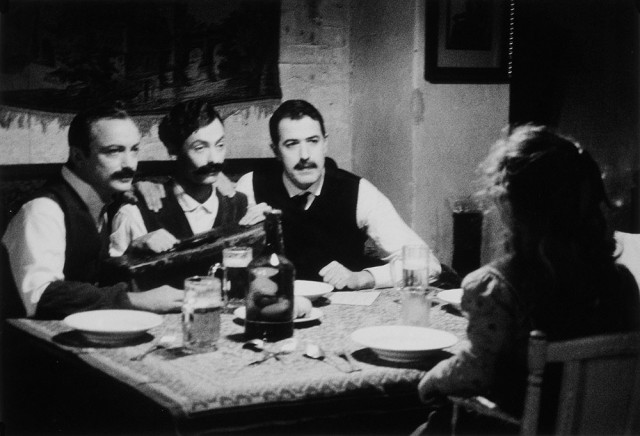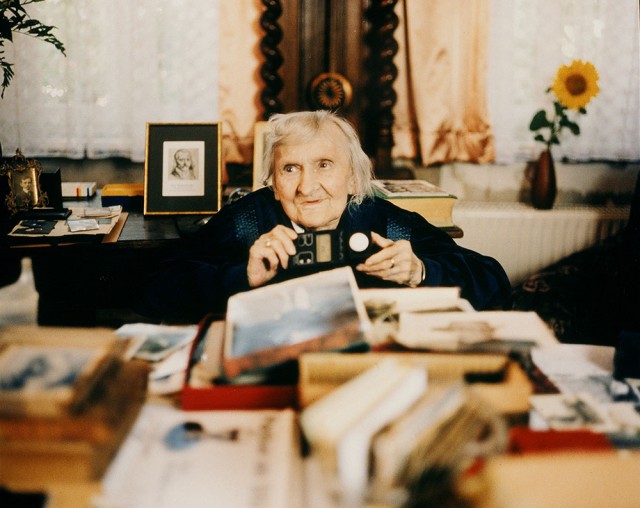
The Skladanowsky brothers attempt to please the demanding Gertrud in Wim Wenders’s affectionate early-cinema tribute, A TRICK OF THE LIGHT
A TRICK OF THE LIGHT (DIE GEBRÜDER SKLADANOWSKY) (Wim Wenders, 1995)
IFC Center
323 Sixth Ave. at Third St.
Through September 24
212-924-7771
www.ifccenter.com
www.wim-wenders.com
 German director Wim Wenders pays tribute to the invention of cinema in the charming, delightful, yet bittersweet 1995 film A Trick of the Light, finally getting its long-overdue U.S. theatrical premiere engagement at the IFC Center. Using a vintage 1920s hand-crank camera for the old-fashioned black-and-white silent flashback scenes (shot at eighteen frames per second) that make up the bulk of the film, Wenders and cinematographer Jürgen Jürges iris in and out to tell the story of the real-life Skladanowsky brothers, who were inventing a mechanism to project moving pictures in the late nineteenth century, only to have their work, the bioskop, overshadowed by the Lumière brothers’ cinématographe. The technical genius is Max Skladanowsky (Udo Kier), who films the comic exploits of his brother, Eugen (Christoph Merg), while sibling and ladies’ man Emil (Otto Kuhnle) does the editing and runs the projector. Cheering them on is Max’s demanding young daughter, Gertrud (Nadine Büttner), who wants her father and uncles to capture a more precise depiction of reality. Meanwhile, a spy (Alfred Szczot) keeps a close eye on what they are doing. Working with students from his University of Television and Film Munich class, Wenders occasionally intercuts scenes in almost garish full color in which he interviews Max’s last surviving daughter, ninety-one-year-old Lucie Hürtgen-Skladanowsky, in the same house the family has owned since 1907.
German director Wim Wenders pays tribute to the invention of cinema in the charming, delightful, yet bittersweet 1995 film A Trick of the Light, finally getting its long-overdue U.S. theatrical premiere engagement at the IFC Center. Using a vintage 1920s hand-crank camera for the old-fashioned black-and-white silent flashback scenes (shot at eighteen frames per second) that make up the bulk of the film, Wenders and cinematographer Jürgen Jürges iris in and out to tell the story of the real-life Skladanowsky brothers, who were inventing a mechanism to project moving pictures in the late nineteenth century, only to have their work, the bioskop, overshadowed by the Lumière brothers’ cinématographe. The technical genius is Max Skladanowsky (Udo Kier), who films the comic exploits of his brother, Eugen (Christoph Merg), while sibling and ladies’ man Emil (Otto Kuhnle) does the editing and runs the projector. Cheering them on is Max’s demanding young daughter, Gertrud (Nadine Büttner), who wants her father and uncles to capture a more precise depiction of reality. Meanwhile, a spy (Alfred Szczot) keeps a close eye on what they are doing. Working with students from his University of Television and Film Munich class, Wenders occasionally intercuts scenes in almost garish full color in which he interviews Max’s last surviving daughter, ninety-one-year-old Lucie Hürtgen-Skladanowsky, in the same house the family has owned since 1907.
Hürtgen-Skladanowsky shares fond memories while examining old photo albums, hand-colored glass plates, and other artifacts from her father’s and uncles’ heyday; she also shares her thoughts on the flashback scenes with Wenders and his small crew. Wenders, Jürges, camera assistant German Kral, soundwoman Barbara Rohm, and sound assistant Florian Gallenberger are shown sitting across the table from Lucie, who entertains them with her comments and recollections. Wenders adds a nostalgic touch by having Gertrud and Eugen occasionally enter the modern-day scenes, turning the film back into black-and-white. Also deserving of praise is Peter Przygodda’s editing and Laurent Petitgand’s lovely carnivalesque score, which help beautifully capture the look, feel, and sound of early cinema. The main film is only about an hour long, but fifteen minutes of credits include fun bonuses. A Trick of the Light, which is “dedicated to the many forgotten pioneers of film,” is part of the IFC Center’s “Wim Wenders: Portraits Along the Road” tribute to the iconoclastic director, playwright, and photographer on the occasion of his seventieth birthday; the series continues through September 24 with such other works as Buena Vista Social Club, Nick’s Film: Lightning over Water, The Soul of a Man, Tokyo-Ga, Pina, and a sneak preview of Every Thing Will Be Fine in 3D.
